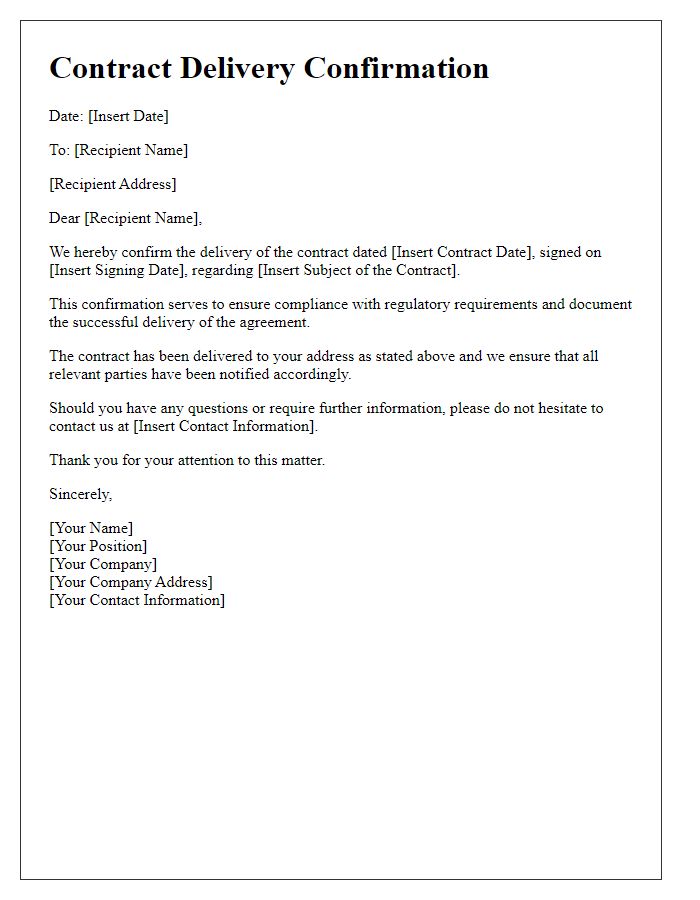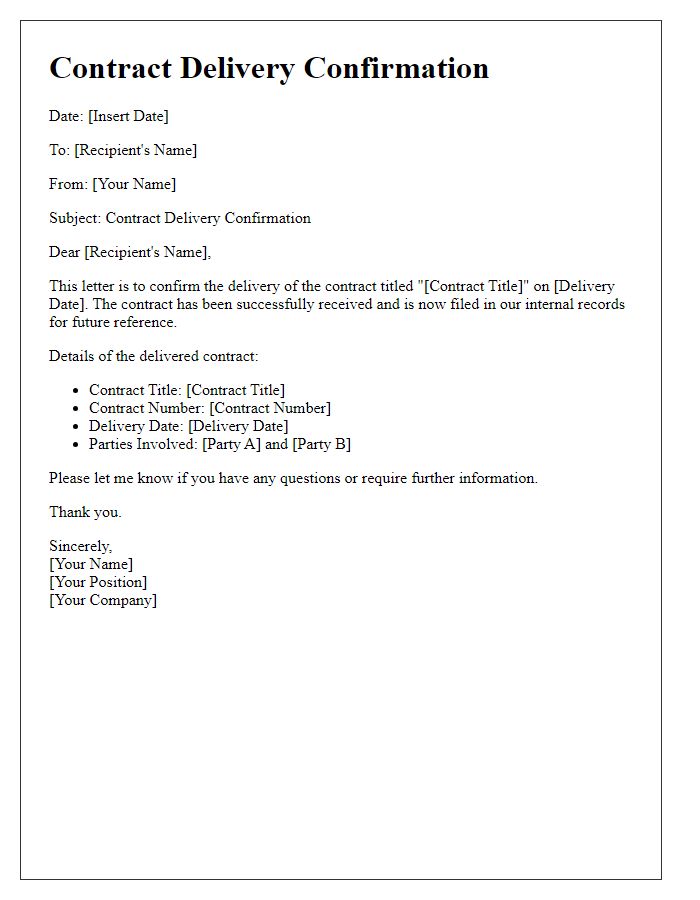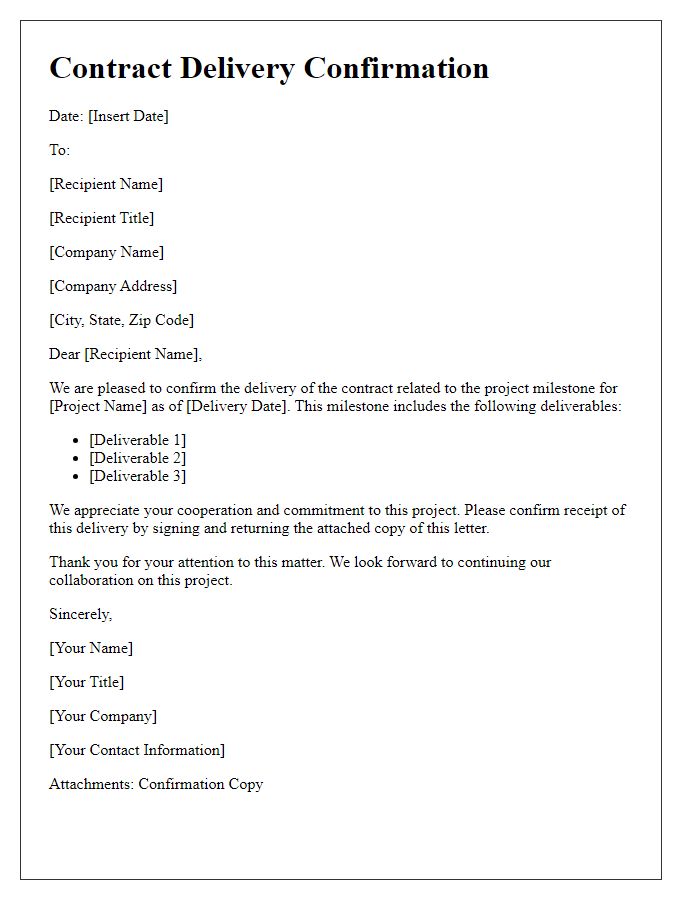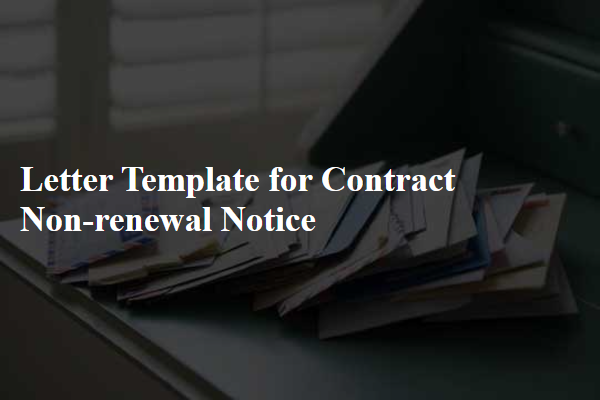Hello there! If you've ever wondered about the best way to confirm the delivery of a contract, you're in the right place. Clearly communicating the receipt of important documents is essential for smooth business operations, and a well-crafted letter can ensure everyone is on the same page. So let's dive into some practical tips and examples that will make your contract delivery confirmations not only efficient but also professionalâread on to discover more!

Clarity of Contract Details
Clarity in contract details is essential for effective communication between parties involved in legal agreements, such as service contracts, sales agreements, or employment contracts. A precise contract should explicitly outline key elements, including the scope of work, payment terms of 30 days post-invoice submission, delivery deadlines, and termination clauses. Specific language reduces ambiguity, ensuring all parties understand and agree on their rights and responsibilities. Additionally, referencing pertinent regulations, such as the Uniform Commercial Code in the United States, can enhance contract enforceability. Thoroughly reviewing contract details can prevent disputes and facilitate smoother business operations, ultimately fostering successful relationships among stakeholders.
Confirmation of Delivery Terms
The confirmation of delivery terms outlines the key details relating to the successful delivery of goods or services, ensuring clarity and mutual understanding between parties involved. Delivery confirmation typically includes vital information such as delivery date and time, the names of sender and receiver, shipping method--whether air freight, sea freight, or ground transportation--and any tracking numbers associated with the shipment. Additionally, it may specify the condition of goods upon arrival, relevant documentation--such as bills of lading or invoices--and any applicable warranties or guarantees in place. Clear articulation of these terms minimizes the potential for disputes and facilitates smooth transactions between businesses across various industries.
Accurate Contact Information
Accurate contact information is essential for successful contract delivery confirmation. Key details include recipient's full name (ensuring clarity and reducing misdelivery), correct street address (to prevent delays in postal services like USPS or DHL), phone number (to facilitate quick communication in case of issues), and email address (for digital confirmations and attachments). Verification of this information minimizes the risk of complications in contract execution, ensuring timely receipt by involved parties. Regular updates to contact records can enhance reliability, especially for large organizations managing numerous contracts simultaneously.
Acknowledgment Receipt Statement
Acknowledgment receipts serve as critical documentation in the context of contract delivery confirmation. Such statements ensure clarity regarding the receipt of important documents, such as legal agreements or significant contracts. Acknowledgment receipts typically include vital information, such as the sender's name (individual or entity), the recipient's name, delivery date, and specific contract details (e.g., contract number, type, or subject matter). These receipts act as a formal validation that the intended party has received the documents, mitigating potential disputes over delivery and acceptance. For example, a delivery confirmation might note that a real estate purchase agreement was received by the buyer on November 10, 2023, ensuring both parties are aligned on the transaction timeline.
Signature and Date Fields
A contract delivery confirmation process typically requires specific elements to establish an official record of receipt. Signature fields must be present, allowing parties to acknowledge agreement to the terms set forth. Date fields should accompany signatures to mark the exact time and date of the confirmation. This ensures clarity regarding when the contract was officially accepted. Additionally, including a designated space for the printed name of each signer provides context for accountability. Formal documents often use title fields to clarify the signer's role within an organization, enhancing legal validity. Finally, clear labeling of the document as a "Contract Delivery Confirmation" at the top helps in organizing records efficiently.
Letter Template For Contract Delivery Confirmation Samples
Letter template of Contract Delivery Confirmation for Client Acknowledgment

Letter template of Contract Delivery Confirmation for Vendor Notification

Letter template of Contract Delivery Confirmation for Regulatory Compliance

Letter template of Contract Delivery Confirmation for Partnership Agreement

Letter template of Contract Delivery Confirmation for Franchise Agreement

Letter template of Contract Delivery Confirmation for Employment Contract








Comments